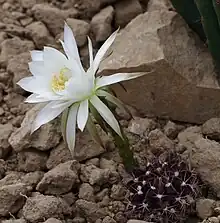| Lobivia obrepanda | |
|---|---|
 | |
| Scientific classification | |
| Kingdom: | Plantae |
| Clade: | Tracheophytes |
| Clade: | Angiosperms |
| Clade: | Eudicots |
| Order: | Caryophyllales |
| Family: | Cactaceae |
| Subfamily: | Cactoideae |
| Genus: | Lobivia |
| Species: | L. obrepanda |
| Binomial name | |
| Lobivia obrepanda (Salm-Dyck) K. Schum.1894 | |
| Synonyms | |
| |
Lobivia obrepanda, is a species of Lobivia found in Bolivia.[2]
Description
Lobivia obrepanda usually grows singly and occasionally forms small groups as it gets older. The depressed, spherical, dark or gray-green shoots reach a diameter of up to 20 centimeters. There are 13 to 18 sharp-edged ribs, which are divided into hatchet-shaped cusps. The gray areoles are located in the notches and are about 2 centimeters apart. Slightly curved, white to brownish thorns emerge from them. The one to three central spines, which can occasionally be missing, are curved at the tip and 2 to 5 centimeters long. The six to 13 marginal spines, which are mostly arranged in a comb shape, are up to 1 centimeter long.
The funnel-shaped, parsley-scented, white to magenta-red flowers open at night. They are 10 to 20 centimeters long. Its flower tube is slightly curved. The outer bracts are spread out, the inner ones curve upwards. The spherical fruits are semi-dry.[3]
.jpg.webp) Flowers
Flowers

Distribution
Lobivia obrepanda distributed in the Bolivian departments of Santa Cruz, Cochabamba and Chuquisaca at low to high altitudes.
Taxonomy
The first description as Echinocactus obrepandus by Joseph zu Salm-Reifferscheidt-Dyck was published in 1845.[4] The specific epithet obrepanda is derived from the Latin words ob- for 'reverse' and repandus for 'dissolute' and refers to the humps of the ribs. Boris O. Schlumpberger placed the species in the genus Lobivia in 2012. Further nomenclature synonyms are Echinopsis obrepanda (Salm-Dyck) K.Schum. (1894) and Pseudolobivia obrepanda Backeb. ex Krainz (1942)
References
- ↑ "The IUCN Red List of Threatened Species". IUCN Red List of Threatened Species. 2010-09-22. Retrieved 2023-10-02.
- ↑ "Echinopsis obrepanda". Tropicos. Retrieved 2019-08-22.
- ↑ Anderson, Edward F.; Eggli, Urs (2005). Das grosse Kakteen-Lexikon (in German). Stuttgart (Hohenheim): Ulmer. p. 237–238. ISBN 3-8001-4573-1.
- ↑ Dietrich, Albert; Otto, Friedrich (1845). "Allgemeine Gartenzeitung". Biodiversity Heritage Library. Retrieved 2023-10-02.
External links
 Media related to Lobivia obrepanda at Wikimedia Commons
Media related to Lobivia obrepanda at Wikimedia Commons Data related to Lobivia obrepanda at Wikispecies
Data related to Lobivia obrepanda at Wikispecies
